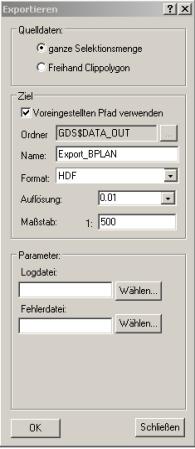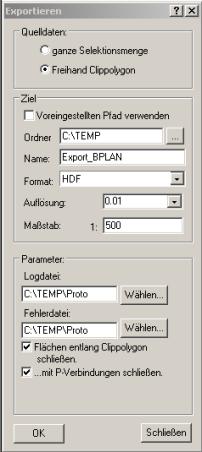Dialog zur Unterstützung des Datenexports von Moskito-Daten in einen neuen Plan als benutzerfreundliche Umsetzung des Export-Befehls der Kommandosprache. Prinzipiell stehen als Quelldaten entweder die gesamte Selektionsmenge oder die Schnittmenge aus Selektionsmenge und einem interaktiv zu erstellenden Clippolygon zur Verfügung.
![]()
![]()
Im Bereich Zieldatei werden die Spezifikationen für die Zieldatei angegeben:
Name: Name der Zieldatei. Die Zieldatei wird in dem Verzeichnis abgelegt, das durch die Variable GDS$DATA_OUT definiert ist. Der Pfad kann unter Verwalten|Einstellungen|Pfade eingesehen und verändert werden. Ist die Variable nicht besetzt, wird die Zieldatei im Verzeichnis main.nt abgelegt.
Format: Auswahl der zur Verfügung stehenden Exportformate.
Maßstab: Planmaßstab der Zieldatei.
Auflösung: Hier wird die Datengenauigkeit definiert, auf die gerundet wird. Grundlage ist die Basis-Längeneinheit, in der Regel der Meter. Eine Auflösung von 0.01 entspräche also einer Genauigkeit im Zentimeterbereich. Manche Austauschformate benötigen diese Information zur Anlage der Datei.
Im Bereich Parameter werden Einstellungen zur Konvertierung gemacht. Es gibt einen allgemeinen Teil in diesem Dialog und einen speziellen, formatabhängigen Teil in einem weiteren Dialog, der über den Knopf weitere Einstellungen geöffnet werden kann. Wenn ein Export durch Drücken von OK durchgeführt wird, werden die Einstellungen gespeichert und stehen beim nächsten Aufruf des Dialogfensters wieder zur Verfügung.
Unter Logdatei wird der vollständige Dateinamen der Logdatei (inkl. Pfad) eingetragen. In der Logdatei sind formatabhängige Konvertierungsregeln definiert.
Wenn mit Hilfe eines Clippolygons exportiert werden soll, kann bestimmt werden, dass die Flächen, die vom Clippolygon zerschnitten werden, geschlossen werden. Standardmäßig geschieht das dann mit #L-Verbindungen. Über das zusätzliche Ankreuzfeld kann angegeben werden ob stattdessen #P-Verbindungen eingesetzt werden sollen.
--------------------OLD_TEXT---------------------
Dialogue to the support of the data export of Moskito's data in a new plan as a user-friendly conversion of the export order of the Kommandosprache. In principle are available as source data either the whole selection amount or the cut amount from selection amount and a clip polygon interactively to be provided.


In the area of Aim file the specifications are given for the aim file:
Name: Name of the aim file. The aim file is filed in the list which is defined by the variable GDS$DATA_OUT. The path is able under Verwalten|Einstellungen|Pfade are seen and are changed. If the variable is not taken, the aim file is filed in the list main.nt.
Format: Choice of the available export formats.
Graduation: Plan graduation of the aim file.
Resolution: Here the data exactness on which is rounded is defined. Basis is the base unit of length, as a rule the metre. A resolution of 0.01 would correspond to an exactness in the centimetre area. Some exchange formats need this information about the arrangement of the file.
In the area of parametres settings to the conversion are made. There is a general part in this dialogue and a special part dependent on format in an other dialogue, about the button other settings it can be opened. If an export by pressure from OK it is carried out, the settings are stored and are available by the next call of the dialogue window again.
Under log file it is put down of the entire file names of the log file (incl. path). In the log file conversion rules dependent on format are defined.
If should be exported with the help of a clip polygon, can be determined that the surfaces which are cut by the clip polygon are closed. Then normally this happens with #L-Verbindungen. Above the additional field Ankreuz can be given whether instead #P-Verbindungen should be used.